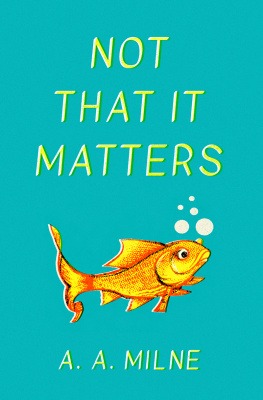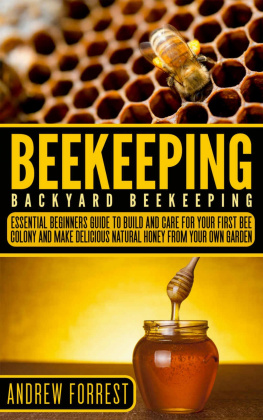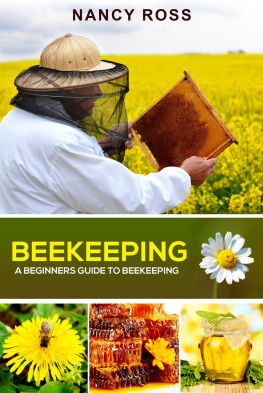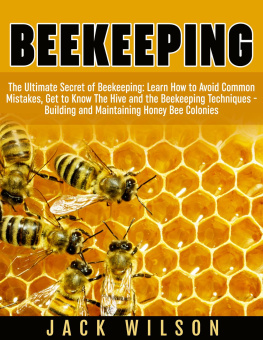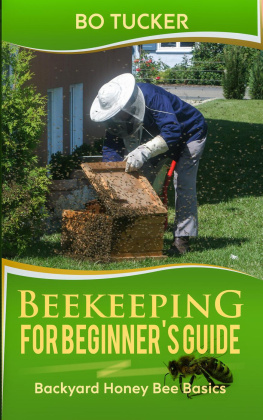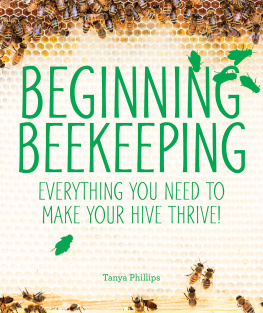Beekeeping for Beginners
How to Make and Raise Your first Bee Colonies
Charles Milne
Copyright by Charles Milne All rights reserved.
This eBook is provided with the sole purpose of providing relevant information on a specific topic for which every reasonable effort has been made to ensure that it is both accurate and consistent. Nevertheless, by purchasing this eBook, you consent to the fact that the author, as well as the Publisher, are in no way experts on the topics contained herein, regardless of any claims as such that may be made within. As such, any suggestions or recommendations that are made within are made so purely for entertainment value. It is recommended that you always consult a professional before undertaking any of the advice or techniques discussed within.
This is a legally binding declaration that is considered both valid and fair by both the Committee of Publishers Association and the American Bar Association and should be considered as legally binding within the United States.
The reproduction, transmission, and duplication of any of the content found herein, including any specific or extended information, will be done as an illegal act regardless of the end form the information ultimately takes. This includes copied versions of the work, both physical, digital, and audio unless the express consent of the Publisher is provided beforehand. Any additional rights reserved.
Furthermore, the information that can be found within the pages described forthwith shall be considered both accurate and truthful when it comes to the recounting of facts. As such, any use, correct or incorrect, of the provided information will render the Publisher free of responsibility as to the actions taken outside of their direct purview. Regardless, there are zero scenarios where the original author or the Publisher can be deemed liable in an
Sommario
Chapter One
The scientific study of honey bees
It was not until the 18th century that the systematic study of bee colonies was conducted by European natural philosophers and started to understand the fascinating and secret world of bee biology. Swammerdam, Ren Antoine Ferchault de Raumur, Charles Bonnet, and Franois Huber were influential among these research pioneers. Swammerdam and Raumur were also the first to use a microscope and dissection to understand the honey bees' internal biology. Raumur was among the first to create a walled glass observation hive to help monitor hives behavior. He found queens laying eggs in open cells but yet had little idea how to fertilize a queen; no one had ever seen a queen and drone mating, and several hypotheses suggested that queens were "self-fertile," while others claimed that a mist or "miasma" emanating from the drones fertilized queens without any physical interaction. By observation and testing, Huber was the first to show that Queens are physically inseminated by drones beyond the boundaries of hives, usually a great distance apart.
Using the style of Raumur, Huber set up enhanced glass-walled observation hives and sectional hives, which could be opened like a book's leaves. This allowed inspection of individual wax combs and greatly improved direct hive activity observation. Huber hired an assistant, Franois Burns, to make regular reports, perform meticulous studies, and take detailed records for more than twenty years, while he went blind before he was twenty. Huber confirmed that a hive is composed of one queen, who is the mother of both the colony's female workers and male drones. He was also the first to report that mating with drones happens outside of hives and that queens are inseminated by a series of consecutive male drone matches, high in the air at a considerable distance from their hive.
In 1768/1770, for example, Thomas Wildman reported intermediate stages in the transition from the old beekeeping to the modern, explaining improvements over the devastating ancient beekeeping based on cynicism so that the bees were no longer to be destroyed to extract the honey. For example, Wildman installed a parallel pair of wooden bars across the top of a straw hive or skeptic (with a separate straw top to be later mounted) "so that there are in total seven bars" [in a 10-inch (250 mm) hive] "in which the bees fix their combs." He also explained the use of these hives in a multi-story structure, foreshadowing the current use of supers: he explained the introduction (at the right time) of successive straw hives below and finally eliminating those above when free of brood and filled with honey so that the bees could be kept separately at the harvest for the subsequent season.
Evolution of hive designs
Apiarists and inventors on both sides of the Atlantic stumbled upon Langstroth's idea for free comb hives, and a wide variety of mobile comb hives were developed and invented in England, France, Germany, and the United States. Classic designs emerged in each country: Dadant hives and Langstroth hives are still prevalent in the US; the De-Layens trough-hive became popular in France, and a British National hive became common in the UK as late as the 1930s, while the smaller Smith hive remains popular in Scotland. The typical trough hive continued in some Nordic countries and Russia until late in the 20th century and is still retained in some regions. The Langstroth and Dadant designs, however, remain omnipresent in the US and other parts of Europe as well, while Sweden, Denmark, Germany, France, and Italy all have their own national hive designs. Regional hive differences developed to reflect the environment, floral quality, and reproductive characteristics of the different native honey bee subspecies in each bio-region.
The differences in the hive size of all these hives are negligible due to the general factors: they are all square or rectangular; they all use compact wooden frames; they all consist of a base, brood cabinet, honey super, crown board, and roof. Hives have historically been constructed of cedar, oak, or cypress wood, but colonies made from an injection molded dense polystyrene have become increasingly popular in recent years.
Hives often use queen excluders to prevent the queen from laying eggs in cells adjacent to those holding honey meant for consumption between the brood-box and honey supers. Usually, with the introduction of mite pests in the 20th century, hive floors are frequently covered with a wire mesh and flexible tray for part of (or the entire) year.
In 2015 Cedar Anderson and his father Stuart Anderson developed the Flow Hive method in Australia, allowing for the extraction of honey without costly centrifuge machines.
Chapter Two
Benefits of Beekeeping
More and more people around the world realize the need for beekeeping. You may be wondering how it can help you and what changes you can make by being a beekeeper. Needless to say, beekeeping is a beneficial job. The time spent on beekeeping will never be wasted. Knowing the bees and being able to manage the colony successfully will make you proud.
Also, bees are under global pressure. Due to the combined influence of many factors, its population is decreasing, including global warming and the extensive use of pesticides in agriculture, which have the effect of killing a large number of bees.
As a beekeeper, you can enjoy the following main benefits:
Useful and valuable
You will become a producer of useful and valuable things in the world. Beekeeping will enable you to produce honey. It is a popular commodity that can bring you profits. You will also have a lot of honey for your use. The global demand for babies is so high that production rarely fully meets the need. However, it is essential to note that not all beekeepers are engaged in honey production and profit-making purposes.






